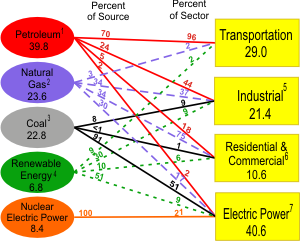|
Last Updated: September 2008
Next Update: August 2009
The primary source of petroleum products is crude oil. Initially crude oil was taken from natural pools on the earth’s surface and was used mainly for medicinal purposes. These pools supplied about 3 gallons a day. As the population expanded and the demand for the oil grew, and as whale oil, an alternative to crude oil, became scarce as a source for lighting, the ability to produce more crude oil was addressed. In Titusville, Pennsylvania, using the same technology as they used to drill for water, producers excavated the first successful oil well in 1859.
What were the main products refined from crude oil at the beginning of discovery? As crude oil became ample, refineries sprang up to process it into useable petroleum products. The main product at that time was kerosene, which began replacing whale oil as the prime source of illumination. Other main petroleum products refined out of a typical 42-gallon barrel (industry standard) were greases and lubricants.
The United States consumes more energy from petroleum than from any other energy source. Although petroleum provides many useful products, the most familar are motor gasoline, diesel fuel and heating fuel. Petroleum is used to heat homes, offices, and factories and is used to fertilize, process, package, distribute, refrigerate, and cook food. Petroleum is also the source of synthetic fabric for clothes as well as detergents and dry cleaning solvent to clean them. Petroleum provides a chemical base for cosmetics and pharmaceutical products as well as form many plastic products from toys to building materials.
|
U.S. Primary Energy Consumption by Source and Sector, 2007(Quadrillion Btu)
 |
Total petroleum products consumption in 2007 was 20.7 millions barrel a day after reaching a record high of 20.8 million barrels a day in 2005. The main petroleum products consumed are motor gasoline, distillate fuel oil like diesel fuel and home heating oil, and propane.
In 2007 motor gasoline consumption reached a record high of 9.29 million barrels a day.
Distillate fuel oil consists of diesel fuels and fuel oils. Diesel fuels furnish power to diesel engines, such as those used in heavy construction equipment, trucks, buses, tractors, trains, and some automobiles. No. 2 fuel oil is utilized in the central heating of homes and small buildings. Distillate fuel oil consumption in 2007 was 4.20 million barrels per day, the highest ever.
Liquefied petroleum gases (LP-gases or LPGs) are mixtures of propane, ethane, butane and other gases that are produced at natural gas processing plants and refineries. Besides fueling a backyard barbeque, propane has many other uses. About 45 percent of propane is used by the chemical industry as a raw material for making plastics, nylon, and other materials. While only a small fraction of propane is used for transportation, it is the largest alternative transportation fuel in use today.
What is the outlook for U.S. petroleum consumption? Transportation use leads growth in liquid fuels consumption. U.S. consumption of liquid fuels—including fuels from petroleum-based sources and, increasingly, those derived from non-petroleum primary fuels such as coal, biomass, and natural gas—totals 22.8 million barrels per day in 2030 in the Annual Energy Outlook 2008. That is an increase of 2.1 million barrels per day over the 2006 total (see figure). All of the increase is in the transportation sector, which accounts for 73 percent of total liquid fuels consumption in 2030, up from 68 percent in 2006.
Gasoline, ultra-low sulfur diesel, and jet fuel are the main transportation fuels. The reference case includes the effects of technology improvements that are expected to increase the efficiency of motor vehicles and aircraft, but the projected growth in demand for each mode outpaces those improvements as the demand for transportation services grows in proportion to increases in population and Gross Domestic Product (GDP). With the new Corporate Average Fuel Economy (CAFE) standards in the Energy Independence
and Security Act of 2007 (EISA2007), transportation use of liquid fuels increases by 2.6 million barrels per day from 2006 to 2030. |
Liquid Fuels Consumption by Sector 1990-2030
(million barrels per day) |

|
| figure data |
Worldwide consumption of petroleum products was 82.3 million barrels a day in 2004.
The three countries that consume the most petroleum products are:
- United States (20.7 million barrels per day)
- China (6.4 million barrels per day)
- Japan (5.4 million barrels per day)
More information on this subject can be found in the following EIA publications:
 Petroleum Supply Annual, Volume I Petroleum Supply Annual, Volume I
 International Petroleum Monthly International Petroleum Monthly
 Monthly Energy Review Monthly Energy Review
 Annual
Energy Review Annual
Energy Review
 Annual
Energy Outlook Annual
Energy Outlook
 International
Energy Annual International
Energy Annual
|

